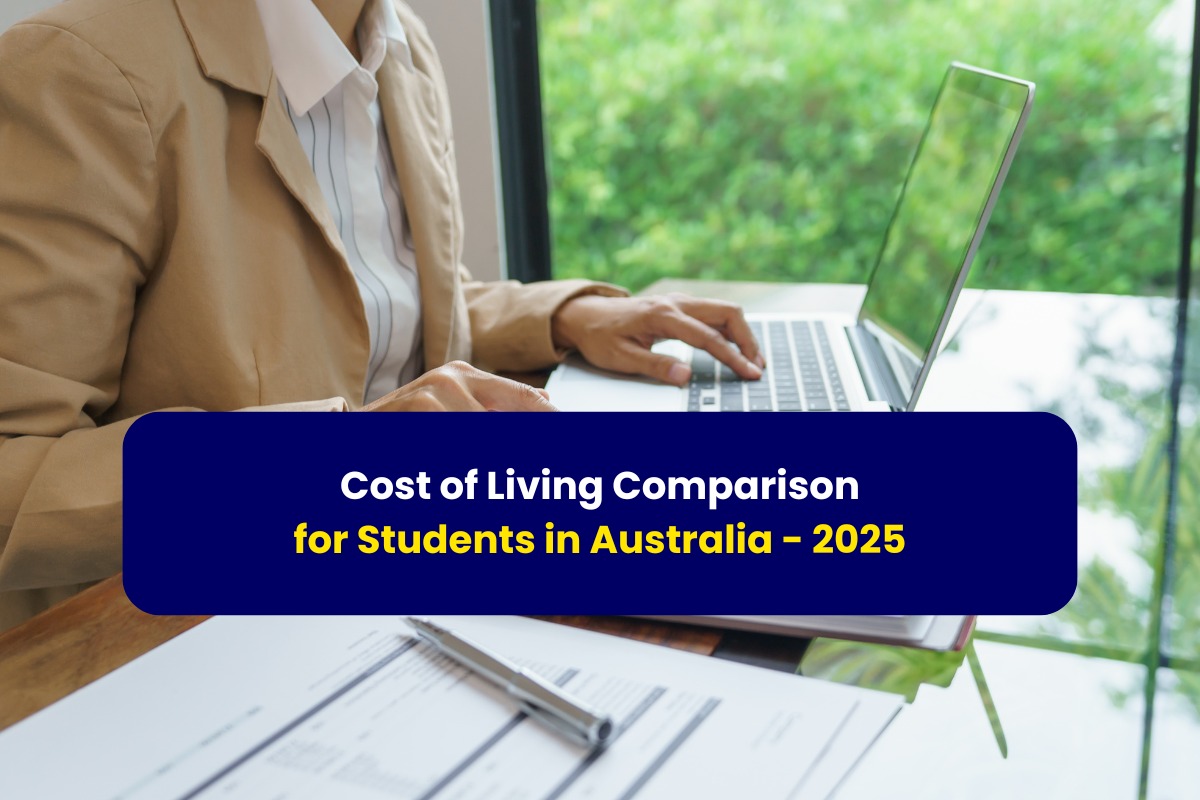Cost of Living Comparison for Students in Australia – 2025

Cost of Living Comparison for Students in Australia – 2025
Thinking about studying in Australia? Start with a cost of living comparison—it's one of the smartest first steps to take when planning. Living costs in Australia differ widely based on which city you choose to stay in. Monthly living expenses in Australia can range from AUD 1,200 to AUD 2,200, depending on the city and lifestyle choices. That’s a difference of over AUD 12,000 a year.
As an Indian student, if you understand these expenses early, you can deal better with financial planning, choose the right city, and avoid money stress. Whether you're planning a tight budget or a more flexible one, this guide can help you stay financially ready throughout your study journey in 2025.
Why Living Costs Matter for International Students
To study abroad, knowing how much money you'll need to live there is important. The cost of living varies depending on the city you select and the lifestyle you lead.
When you plan your budget, you need to consider basic monthly expenses such as rent, groceries, travel, internet, phone bills, and other everyday costs.
This becomes even more crucial for Indian students heading to Australia in 2025. The exchange rate and rising prices can make studying abroad more expensive. Knowing the expected costs can help you and your family prepare financially, apply for scholarships, or look for part-time jobs in advance.
Top Cities Comparison: Overview of Monthly Student Budgets
Choosing the city in Australia can make a big difference to your overall study abroad after 12th grade experience. Below is a quick look at what international students usually spend per month in 2025 in the most popular cities.
| City | Average Monthly Cost (AUD) |
| Sydney | A$2,100 – A$3,000 |
| Melbourne | A$2,000 – A$2,800 |
| Brisbane | A$1,800 – A$2,500 |
| Perth | A$1,700 – A$2,400 |
| Adelaide | A$1,600 – A$2,200 |
Accommodation Costs: City-by-City Breakdown
Shared Rentals vs Private Apartments
Most international students in Australia choose to live in shared houses or apartments because it’s cheaper. Shared rentals mean you share the place, split the rent and utility bills with others. Private apartments give you more space and privacy. However, they tend to be more expensive shared housing.
Cheapest Cities for Student Housing
Before choosing your university in Australia, try to find out the housing options that match your budget and taste. Adelaide and Perth usually offer the lowest rent. Sydney and Melbourne are the most expensive.
Average Rent in 2025
| City | Shared Rental (AUD/month) | Private Apartment (AUD/month) |
| Sydney | A$800 – A$1,200 | A$1,500 – A$2,500 |
| Melbourne | A$700 – A$1,000 | A$1,300 – A$2,200 |
| Brisbane | A$600 – A$900 | A$1,200 – A$2,000 |
| Perth | A$600 – A$800 | A$1,000 – A$1,800 |
| Adelaide | A$600 – A$800 | A$1,000 – A$1,600 |
Food and Groceries: Weekly and Monthly Spending
Grocery Shopping vs Eating Out
Making your meals at home can significantly cut down on costs instead of frequently dining out at cafes or restaurants. Weekly groceries cost around A$100–A$150. Eating out regularly can double your food expenses.
City Differences
Sydney and Melbourne tend to have slightly higher food prices, especially in central areas. Adelaide and Perth are generally more affordable.
Tips to Save Money on Meals
⦁ Shop at local markets and budget supermarkets like ALDI.
⦁ Cook in bulk and freeze meals.
⦁ Use student discounts or apps for food deals.
Transportation: Monthly Passes and Student Discounts
Public transport is reliable and many students use it in Australia. Each city has its own system and fares. Factoring this into your cost of living comparison, especially considering exclusive student concessions, gives you an idea of how much it costs you to get around regularly in any Australian city.
Monthly Public Transport Cost (2025)
| City | Monthly Cost (AUD) |
| Sydney | A$150 – A$200 |
| Melbourne | A$150 – A$200 |
| Brisbane | A$120 – A$150 |
| Perth | A$100 – A$130 |
| Adelaide | A$60 – A$80 |
Student Discounts
Most cities offer special concession cards for students. These can reduce your travel costs by up to 50%. Be sure to apply for your student ID and transit card as soon as you arrive.
Utilities and Internet: What's Included and What's Not
Breakdown of Utility Costs
Utilities include electricity, gas, water, and internet. If you're living in shared accommodation, you usually split these bills.
| Utility Type | Average Monthly Cost (AUD) |
| Electricity & Gas | A$60 – A$100 |
| Water | A$20 – A$40 |
| Internet | A$40 – A$70 |
Seasonal Impact
Utility bills may rise during summer or winter months due to increased use of air conditioning or heaters. It depends on where you live.
Sharing Bills
In shared houses, you and your roommates will typically divide utility costs equally. Certain rental properties may cover some utility bills as part of the rent. Check before signing your lease.
Other Living Expenses to Consider
Mobile Plans and Data
Prepaid mobile plans with data cost between A$20 and A$40 per month. Major providers include Telstra, Optus, and Vodafone.
Entertainment and Eating Out
⦁ Movie ticket: A$15–A$25
⦁ Restaurant meal: A$20–A$35
⦁ Weekend outing: Around A$50–A$100
Clothing, Medical, and Unexpected Costs
⦁ Clothes shopping: Varies depending on brands and seasons. Budget around A$50–A$100 monthly if necessary.
⦁ Health insurance (OSHC): Mandatory for international students. Your expenses will depend on the service provider you choose and how long you stay.
⦁ Unexpected costs: Always keep an emergency fund of at least A$500–A$1,000 for surprises like laptop repair or medical expenses.
Using a Living Expenses Calculator to Plan Ahead
Calculating your budget before your first semester in Australia is one of the smartest things you can do. A great living expenses calculator can help. It is a simple tool that helps you estimate how much money you’ll need every month. You just enter details like your city, lifestyle, and type of accommodation. Then, it gives you a rough idea of your total costs.
How a Living Expenses Calculator Helps
This tool helps you:
⦁ Understand the average costs of rent, food, transport, and more.
⦁ Compare different cities in Australia per your budget.
⦁ Plan early so you can stay within budget and avoid financial stress later.
⦁ Consider if you will need additional financial help, such as scholarships or part-time job opportunities.
Tools and Apps to Try
Here are some helpful living cost calculators:
Study Australia Cost of Living Calculator: An excellent tool by the Australian government, it gives realistic estimates on the basis of your location and lifestyle.
⦁ Study Melbourne Cost of Living Calculator: A great tool for students thinking about studying in Melbourne.
⦁ Numbeo or Expatistan: Global platforms that compare living costs across cities and countries.
Tips for Using a Cost of Living Calculator Effectively
⦁ Be honest about your spending habits: Don’t underestimate your expenses.
⦁ Compare at least 2–3 cities: See which ones fit your budget best.
⦁ Include unexpected costs: Add extra money for things like medical visits, exam fees, or personal items.
⦁ Review regularly: Prices may change, so check again before you move.
Which City Offers the Best Value?
By now, you already understand how the cost of living comparison can vary across Australian cities. Certain Australian cities offer a more budget-friendly lifestyle for students in comparison to others.
High vs Low-Cost Cities
⦁ High-cost cities: Sydney and Melbourne are exciting and full of opportunities, but they’re also the most expensive places to live.
⦁ Medium-cost cities: Brisbane and Perth are slightly cheaper and still offer great universities and a good quality of life.
⦁ Low-cost cities: Adelaide and Hobart are more budget-friendly, especially for rent and transportation.
Affordability Rankings for Students (2025)
Taking into account the average monthly costs (including rent, food, transport, and utilities), here’s a basic affordability ranking for international students from most to least affordable:
⦁ Adelaide
⦁ Hobart
⦁ Brisbane
⦁ Perth
⦁ Melbourne
⦁ Sydney
Best Cities for Indian Students Using Total Budget
If you want to save money, Adelaide, Hobart, or Brisbane are more manageable. These cities offer good education options, cheaper accommodation, and lower transport costs. Sydney and Melbourne are great choices too, with excellent universities. But you’ll need a bigger budget for both your tuition fees and daily expenses.
Rounding Up
Doing a cost of living comparison is one of the best ways to prepare before you study in Australia. It helps you choose the right city, manage your money wisely, and avoid financial surprises. Whether you prefer affordable Adelaide or bustling Sydney, knowing your average expenses gives you confidence. It’s a small step that makes a big difference in helping you stay on track during your study abroad journey.


